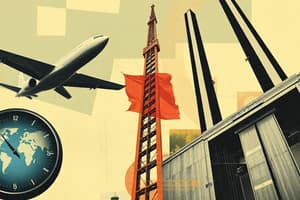Podcast
Questions and Answers
What is the primary function of the traveling cables in a lift system?
What is the primary function of the traveling cables in a lift system?
- Guiding the counterweight to ensure smooth vertical travel.
- Supporting the weight of the lift car within the hoistway.
- Activating the final limit switches in emergency situations.
- Providing electrical connections between the controller in the motor room and the car. (correct)
Compensating chains are typically used in high-speed lifts to counteract the weight of the lifting ropes.
Compensating chains are typically used in high-speed lifts to counteract the weight of the lifting ropes.
False (B)
What is the purpose of the car apron (toe guard) fitted to the bottom of a lift car?
What is the purpose of the car apron (toe guard) fitted to the bottom of a lift car?
prevent a person's foot from being trapped between the landing and the car during the leveling period
Hoistway ropes are secured to the counterweight top frame by screwed ________, which allow rope adjustment.
Hoistway ropes are secured to the counterweight top frame by screwed ________, which allow rope adjustment.
Match the type of buffer with the appropriate lift speed:
Match the type of buffer with the appropriate lift speed:
An Automatic Rescue Device (ARD) is NOT compulsory for buildings that have:
An Automatic Rescue Device (ARD) is NOT compulsory for buildings that have:
According to safety regulations, emergency lights in a lift must be powered for a minimum of 2 hours.
According to safety regulations, emergency lights in a lift must be powered for a minimum of 2 hours.
What is the minimum width (in mm) required for the door opening of a lift designed for handicapped accessibility?
What is the minimum width (in mm) required for the door opening of a lift designed for handicapped accessibility?
In case of a power outage, the __________ is responsible for bringing the lift to the nearest landing floor and opening the doors.
In case of a power outage, the __________ is responsible for bringing the lift to the nearest landing floor and opening the doors.
Match the following lift components with their function:
Match the following lift components with their function:
Which of the following is NOT a primary function of the counterweight in a traction lift system?
Which of the following is NOT a primary function of the counterweight in a traction lift system?
Electromagnetic brakes in lift systems are designed to engage and stop the lift car when the electricity supply is active.
Electromagnetic brakes in lift systems are designed to engage and stop the lift car when the electricity supply is active.
What component ensures the lift car maintains stability during its vertical movement within the hoistway?
What component ensures the lift car maintains stability during its vertical movement within the hoistway?
The drive sheave transmits power to rotate and move the ____________ to lift or lower the lift car.
The drive sheave transmits power to rotate and move the ____________ to lift or lower the lift car.
What material is the car cage primarily made of to ensure passenger safety?
What material is the car cage primarily made of to ensure passenger safety?
Match the component with its function in a lift system:
Match the component with its function in a lift system:
Why is the friction between the drive sheave and hoist ropes an important factor in traction lift systems?
Why is the friction between the drive sheave and hoist ropes an important factor in traction lift systems?
The grooves on a drive sheave are designed to accommodate a minimum of 8 hoist ropes for enhanced grip.
The grooves on a drive sheave are designed to accommodate a minimum of 8 hoist ropes for enhanced grip.
In a building over 24 meters, what specific feature is required to aid firefighters during an emergency?
In a building over 24 meters, what specific feature is required to aid firefighters during an emergency?
Activating the fireman switch in a fire lift allows passengers inside to still call the lift to different landing call points.
Activating the fireman switch in a fire lift allows passengers inside to still call the lift to different landing call points.
What is the primary purpose of the Emergency Battery Operated Power Supply (EBOPS) in a lift system?
What is the primary purpose of the Emergency Battery Operated Power Supply (EBOPS) in a lift system?
The fireman switch in a fire lift is typically located in the ______ corner of the fire lift at the designated floor.
The fireman switch in a fire lift is typically located in the ______ corner of the fire lift at the designated floor.
Match the lift safety operation components with their respective functions:
Match the lift safety operation components with their respective functions:
Why is a designated floor, often the first floor, selected for direct evacuation in the context of fire safety for lifts?
Why is a designated floor, often the first floor, selected for direct evacuation in the context of fire safety for lifts?
Emergency generators are required in all buildings to power the lifts during a power failure, regardless of the height of the building.
Emergency generators are required in all buildings to power the lifts during a power failure, regardless of the height of the building.
What action must be taken to activate the Fireman switch?
What action must be taken to activate the Fireman switch?
Which of the following is NOT a requirement if providing a lift for handicapped individuals is impracticable?
Which of the following is NOT a requirement if providing a lift for handicapped individuals is impracticable?
The lift contractor is responsible for testing the various components of the lift during the commissioning phase.
The lift contractor is responsible for testing the various components of the lift during the commissioning phase.
What is the maximum time period allowed between periodical maintenance checks for a lift?
What is the maximum time period allowed between periodical maintenance checks for a lift?
A lift must be made ______ if found to be defective during examination.
A lift must be made ______ if found to be defective during examination.
Which of the following components belongs in the pit equipment?
Which of the following components belongs in the pit equipment?
An Automatic Rescue Device (ARD) is required in buildings that have emergency generators.
An Automatic Rescue Device (ARD) is required in buildings that have emergency generators.
What is the clear minimum door width required for a lift intended for use by handicapped individuals?
What is the clear minimum door width required for a lift intended for use by handicapped individuals?
A thorough examination of a lift must be done every ______ months.
A thorough examination of a lift must be done every ______ months.
What is the purpose of the fireman's switch in a fire lift?
What is the purpose of the fireman's switch in a fire lift?
Flashcards
Hoistway Ropes
Hoistway Ropes
Ropes that are secured to the counterweight top frame by eyebolts for adjustment.
Car Travelling Cables
Car Travelling Cables
Flexible multi-core cables connecting electrical signals between the motor room and car.
Compensating Ropes & Chains
Compensating Ropes & Chains
Used to balance load on the motor when the elevator car is at the bottom.
Buffers
Buffers
Signup and view all the flashcards
Car Apron
Car Apron
Signup and view all the flashcards
Fireman lift
Fireman lift
Signup and view all the flashcards
Lift safety operations
Lift safety operations
Signup and view all the flashcards
EBOPS
EBOPS
Signup and view all the flashcards
ARD
ARD
Signup and view all the flashcards
Emergency genset
Emergency genset
Signup and view all the flashcards
Designated floor
Designated floor
Signup and view all the flashcards
Fire lift switch
Fire lift switch
Signup and view all the flashcards
Break Glass
Break Glass
Signup and view all the flashcards
Automatic Rescue Device (ARD)
Automatic Rescue Device (ARD)
Signup and view all the flashcards
Lift Requirements for Handicaps
Lift Requirements for Handicaps
Signup and view all the flashcards
Emergency Battery Operated Power Supply
Emergency Battery Operated Power Supply
Signup and view all the flashcards
Size Requirements for Handicapped Lifts
Size Requirements for Handicapped Lifts
Signup and view all the flashcards
Emergency Battery Operated Power Supply (EBOPS)
Emergency Battery Operated Power Supply (EBOPS)
Signup and view all the flashcards
Safety Officer Training
Safety Officer Training
Signup and view all the flashcards
Periodical Maintenance
Periodical Maintenance
Signup and view all the flashcards
Thorough Examination
Thorough Examination
Signup and view all the flashcards
Landing Call Buttons
Landing Call Buttons
Signup and view all the flashcards
Fire Lift
Fire Lift
Signup and view all the flashcards
Operational Test
Operational Test
Signup and view all the flashcards
Lift Signage
Lift Signage
Signup and view all the flashcards
Car Cage
Car Cage
Signup and view all the flashcards
Guide Shoes
Guide Shoes
Signup and view all the flashcards
Lift Motor Room
Lift Motor Room
Signup and view all the flashcards
Electromagnetic Brake
Electromagnetic Brake
Signup and view all the flashcards
Drive Sheave
Drive Sheave
Signup and view all the flashcards
Counterweight
Counterweight
Signup and view all the flashcards
Hoist Rope
Hoist Rope
Signup and view all the flashcards
Lift Well
Lift Well
Signup and view all the flashcards
Study Notes
Learning Outcomes
- Understanding various major components in lift installation is a key outcome.
- Understanding the functions of major components is important.
- Understanding safety functions in lift installations is crucial.
- Testing and commissioning of lift installations are also part of the learning objectives.
Traction Lift
- A diagram of a traction lift and its components is available.
- The lift's components are labeled in the diagram.
Car Cage
- The car cage is constructed from fire-resistant material.
- The cage is supported by a structural framework connected to hoisting ropes.
Lift Car Stability
- Guide shoes fixed to the side of the structural frame of the car ensure stability during vertical travel.
- The lift car slides along guide rails fastened on both sides of the hoistway.
Lift Motor Room
- A diagram illustrates the motor room's components.
- Components shown include brake, motor, gears, drive sheave and hoist rope.
Lift System
- A diagram illustrates the overall lifting system components.
Guide Shoes & Rail
- Diagrams show the relationship between guide shoes, guide rails and the lift car.
- The illustration also shows a lubricant component.
Traction Machine
- Diagrams present the traction machine's various components.
- The components include sheave, brakes, drums and bedplate.
Electromagnetic Brake
- Electromagnetic brake operation is triggered when the electrical power supply is interrupted.
- The brake assembly is composed of two brake shoes lined with pads.
- Spiral springs hold the pads onto the brake drum.
Drive Sheave
- The drive sheave is a pulley that transmits power to rotate the hoist ropes.
- It's typically constructed from steel and contains grooves for the hoistropes.
- Wear and tear on the hoistropes are possible due to the traction nature of the lift.
Counterweight
- Provide traction by balancing the car weight and a proportion of the load.
- This reduces the motor size to improve efficiency.
- Counterweights are cast-iron sections mounted in a steel framework.
Car Travelling Cables
- Electrical connections (power and signal) between the controller and the car are accomplished through multi-core hanging flexible cables.
Final Limit Switches
- Diagrams illustrate final limit switches.
Compensating Ropes & Chains
- The weight of the lifting ropes increases when the car is at the bottom, increasing the motor load, particularly in high-rise lifts.
- Low-speed lifts often use compensating chains instead of ropes.
Buffers
- Spring buffers are typically used in slow-speed lifts.
- Oil buffers are generally employed for higher-speed lifts.
Hall Call Buttons, Lanterns & Floor Indicators
- Visual representations of hall call buttons, lanterns, and floor indicators are provided.
Safety Devices & Operation
- Car aprons (or toe guards) are fitted to the lift car to prevent entrapment between the car and the landing during the leveling period.
Fireman Lift
- Fireman lifts are used for emergency evacuation in high-rise buildings often located on the ground floor.
- The lift is equipped with a fire lift switch.
Lift Safety Operations
- Emergency Battery Operated Power Supply (EBOPS), including power supply, lighting, ventilation fan and alarm bell operation is described.
- Automatic rescue device (ARD) operation is outlined – for rescuing passengers in cases of lift entrapment.
Overspeed Governor
- A diagram helps visualize the overspeed governor.
- The overspeed governor's components include anchor pin, flyweight and stationary ratchets which prevent over-speeding, critical for safety.
EBOPS Details
- EBOPS (Emergency Battery Operated Power Supply) details, including duration and purpose are elaborated.
- Duration of EBOPS power supply is a critical safety factor for lift operation during outages.
ARD Procedures
- Automatic Rescue Device (ARD) procedures, including procedures to release passengers from an entrapment, are highlighted.
- The device is useful for rescuing trapped passengers during an outage, enhancing passenger safety.
Lift Requirements for Handicapped
- Minimum lift dimensions, door opening, and positioning of control buttons, grab bars and other key elements to ensure accessibility are detailed.
- Diagrams indicate lift clearances, grab bars, and control buttons.
Wheelchair Stairlift or Platform Lift
- Wheelchair stairlifts and platform lifts offer alternative means for vertical circulation of people with mobility limitations, which can be used when lift or ramp installations are not practical.
- The diagram shows illustrations of these methods.
Lift Requirement for Handicaps (Revised)
- Lift accessibility details are presented again, emphasizing dimensions, placement and functionality of safety components.
- Illustrations include details on stairlifts and platform lifts, enhancing understanding of alternative lift designs for accessibility.
Testing and Commissioning
- Contractor responsibilities are outlined concerning testing various lift components.
- Inspections for safety and proper installation of signages are highlighted.
Statutory Requirements
- Safety Officer training in rescue, and periodical maintenance criteria (within a month), with specific details like annual tests, 5-year load tests, etc. are explained.
Summary 1
- Categorized list of main lift components with descriptions, including motor room equipment, hoistway components, etc.
- Classification of safety devices (and their operation) – including terminal limit switches, safety gear, car apron and counterweight components.
Summary 2
- Summary of EBOPS, its importance & operation during power disruptions.
- An explanation of the Automatic Rescue Device (ARD) & its functions in emergency lift situations.
Summary 3
- Summary on lift requirements for people with disabilities, including dimensions for accessibility and suitable alternatives like stairlifts and platform lifts.
- Clear specifications for lift components for accessible design.
Summary 4
- Summary of preventive maintenance of lifts.
- Includes maintenance schedules, safety officer requirements, and required examination frequency for maintenance and safety checks.
- Provides detail on the maintenance requirements of lifts.
Studying That Suits You
Use AI to generate personalized quizzes and flashcards to suit your learning preferences.




